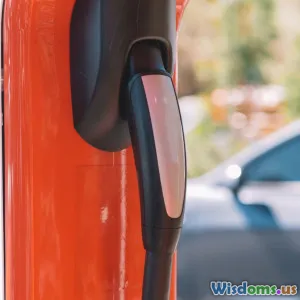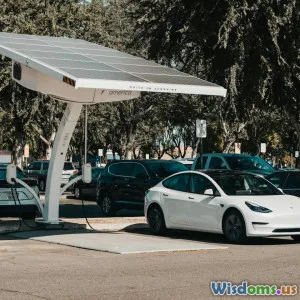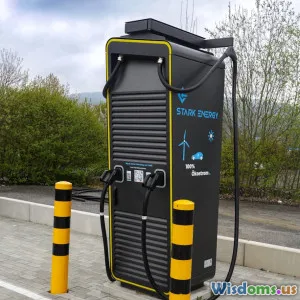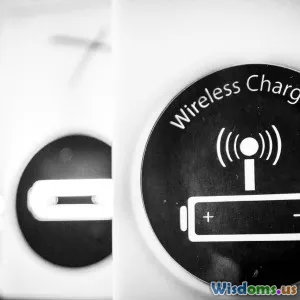
A Beginners Guide To Caring For EV Batteries
17 min read Discover essential tips and best practices for maintaining and extending the life of electric vehicle (EV) batteries as a new owner. (0 Reviews)
A Beginner’s Guide to Caring for EV Batteries
The electric vehicle (EV) revolution is transforming our roads, parking lots, and driveways. As EV models become more advanced and accessible, an ever-growing number of drivers are plugging in. While the benefits of electric propulsion are compelling—minimal emissions, lower operating costs, instant torque—one central component demands attention for a lasting and satisfying ownership experience: your EV’s battery.
Proper battery care doesn't have to be intimidating. With a few practical strategies, you can ensure your battery performs reliably for years, maintains value, and supports sustainability. Here’s a professional’s guide packed with real-world tips, facts, and examples to help you keep your EV running at its electric best.
Understanding the Heart of Your EV: The Battery Pack

Your EV's battery pack is not just an oversize version of your phone battery—it's a complex energy storage system with safety, management, and cooling technologies built in. Almost every modern EV relies on lithium-ion cells, chosen for their high energy density and long cycle life. A typical pack contains hundreds or thousands of these cells, managed together to deliver powerful, consistent output.
Why Are Lithium-Ion Batteries Used?
- Energy Density: Lithium-ion batteries store more energy per kilogram than alternatives, for longer driving range.
- Longevity: With proper care, these batteries provide 8–15 years of useful service in an EV.
- Efficiency: They can charge/discharge rapidly to support fast charging and strong acceleration.
Real-world example: The battery in a Tesla Model 3 Long Range has a usable capacity of about 75 kWh, translating into over 300 miles per charge—but only when treated right!
Key facts:
- Most EV warranties cover batteries for at least 8 years or 100,000 miles.
- Battery health can be checked via an EV’s built-in diagnostics or by a service technician.
Charging Wisely: Strategies for Longer Life

How, when, and where you charge your EV has a profound effect on its battery health. Not all charging is created equal, and smart, mindful charging makes a difference that can extend your battery’s lifespan.
Level 1, 2, and DC Fast Charging: What’s the Difference?
- Level 1 (120V, home outlet): Slow and gentle, typically adds 3–5 miles of range per hour. This method stresses the battery the least.
- Level 2 (240V charging station): Faster, common at home and public chargers, provides 20–30 miles of range per hour—still very healthy for battery longevity.
- DC Fast Charging (public rapid chargers): Ultra-fast, can charge up to 80% in under an hour—great for road trips, but repeated use can heat and degrade the battery more quickly over time.
Pro Tips for Healthy Charging
- Favor Slow and Steady: Regularly using Level 1 or 2 charging is gentler and supports long-term battery health. Treat DC fast charging as an occasional convenience, not a daily habit.
- Avoid Charging to 100% Routinely: Most manufacturers recommend keeping daily charge levels between 20% and 80%. Charging to a full 100% is safest when you immediately plan a long trip.
- Unplug After Charging: Don’t leave your vehicle plugged in at full charge for extended periods, especially in hot conditions.
Real-world insight: Fleet operators such as taxi services have observed that EVs relying mainly on fast charging often see battery degradation rates up to twice as high as those using moderate, home-based charging.
Temperature Matters: Keeping Batteries Cool (and Warm)

Temperature is a crucial factor affecting both battery performance and longevity. Lithium-ion batteries dislike extremes. Both excessive heat and biting cold can reduce battery capacity, efficiency, and speed up wear.
Effects of Heat
- Degradation Risk: Hot climates accelerate chemical reactions inside the cell, leading to faster aging. For example, a battery constantly exposed to temperatures above 86°F (30°C) can lose 20-30% more capacity over its lifetime.
- Parking Tips: Always try to park in the shade during hot days or inside a garage. Many EVs allow you to precondition the cabin and battery while remaining plugged in—use this feature to manage temperatures efficiently.
Effects of Cold
- Immediate Range Loss: Low temperatures can reduce range by 20-40% due to increased resistance and heaters running.
- Long-Term Care: Avoid charging frequently to 100% overnight in freezing temperatures. Use thermal management settings if available, and always allow the battery to warm up before driving distances.
Example: The Nissan Leaf, lacking active battery cooling in older models, is known to degrade faster in hotter southern states than in cooler regions.
State of Charge: The Sweet Spot Explained

A battery’s “state of charge” (SOC) is like its fuel tank level. Many new EV owners experience range anxiety—the fear of not having enough charge—but constantly charging to 100% or keeping the battery depleted are both poor habits.
The 20–80 Rule
- Experts recommend maintaining your SOC between 20% and 80% for daily driving. This avoids high voltage stress at the top, and deep discharges at the bottom—both of which accelerate aging.
- Most EVs have "charge limits" you can set in the software. Set yours at 80% unless you truly need a 100% top-up for a long journey.
Occasional Full Charges Won’t Hurt
- Modern battery management systems (BMS) cope with infrequent full charges and deep discharges. Don’t worry if you sometimes stray outside the 20–80% zone—just keep it rare.
Helpful practice: Tesla, Polestar, and Hyundai all include configurable charge limits. Many apps allow scheduling charging stops so your battery tops off right as you’re leaving—minimizing time at 100%.
Storage Smarts: What to Do When Parking or Not Driving

Long periods of stillness—say, an extended vacation or parking during winter—pose their own challenges. Failure to plan could mean returning to a bricked vehicle or unexpected degradation.
Steps for Long-Term Parking
- Charge to 50–70% Before Parking: This SOC range is safest for extended periods and limits both cell voltage stress (above 80%) and deep discharge risk (below 30%).
- Avoid Full or Empty: Neither extreme is good. If your car will sit for weeks, keep it plugged in with its charge limit set to around 50%.
- Check Battery Health: Some brands (like Tesla) allow you to monitor battery status via mobile app. Check remotely to ensure things are healthy.
- Climate Control: Park in a garage or shaded area. If possible, avoid storing your EV where it will experience high heat or freezing cold.
Case study: Many snowbirds who store Teslas in the Southwest for months use the “Storage Mode” or a purposely set low charge threshold to protect the pack. Even after six months, the battery typically retains nearly all its capacity with these precautions.
Software and Updates: Modern BMS to the Rescue

Modern EVs are sophisticated computers on wheels. Advanced battery management systems (BMS) oversee safety, charging, balancing, and temperature regulation—constantly working behind the scenes to prolong battery life.
The Importance of Updates
- Firmware improvements: EV manufacturers often release over-the-air updates that improve charging rate algorithms, recalibrate range predictions, and optimize battery thermal profiles. Always keep your car’s software up to date.
- Battery Rebalancing: Some models periodically balance the charge across cells, prolonging pack health and ensuring accurate range readings. This process may require an occasional deep charge/discharge; consult your manual to see if it's required, particularly with older EVs.
Real-world change: After an over-the-air update in 2021, Ford Mustang Mach-E owners reported both improved charging speed and up to 12% better estimated range as the BMS was fine-tuned.
Recognizing Signs of Battery Trouble

With EVs, classic “engine trouble” is rare. Instead, be on the lookout for warning signs related to your battery:
- Noticeable Range Drop: A sustained, unexplained loss in daily range is the clearest sign battery health is declining. Temporary range changes (like in winter) are normal and reversible.
- Warning Lights: Most EV dashboards will illuminate battery alerts if something’s amiss.
- Slow Charging: If your vehicle refuses to charge quickly or at usual speeds, this could indicate a problem.
- Unusual Heat: A battery that routinely runs hot during mild weather may have a cooling fault.
What to Do
Don’t wait—schedule a checkup at an authorized service center. Many issues can be solved with diagnostics, firmware repairs, or even a simple software reset. Early intervention saves money and keeps your EV safe.
Environmental Factors: Taking Care for the Planet—and Your Wallet

Using an EV is already a move toward environmental sustainability, but mindful battery care multiplies these benefits and can maximize your savings in the long run.
Sustainable Charging Habits
- Off-Peak Charging: Charging at night, when the energy grid is less loaded, reduces battery stress and capitalizes on lower rates in many regions.
- Integrate Renewables: If you have solar panels, charging during peak sunlight hours can slash your carbon footprint.
- Battery Recycling: Once your pack eventually wears down, reputable carmakers provide take-back and recycling programs; never dispose of batteries in regular waste.
Expert insight: In Nordic countries, owners who pair home solar with scheduled, off-peak EV charging have the lowest lifetime running costs—sometimes less than a traditional gasoline car after a few years!
Real-World Myths—Debunked

It’s easy to be misled by online rumors and old wisdom from the world of portable electronics. Here’s what not to worry about:
-
Myth: "You must always fully discharge before charging."
- Fact: Contrary to old advice about NiCad batteries, lithium-ion cells prefer shallow discharges and benefit from regular top-ups.
-
Myth: "Leaving your EV plugged in overnight is bad."
- Fact: Modern BMS systems prevent overcharging. However, don’t let your car sit at 100% charge for days on end.
-
Myth: "Batteries always need costly replacement every few years."
- Fact: With normal care, battery packs commonly retain 70–80% capacity after 8–10 years. CATL, a leading supplier, claims new designs can last for over a million miles with minimal fade.
Everyday Tips: A Battery Mindset for EV Longevity

- Learn Your Car’s Charge Settings: Explore your vehicle’s menu for controls related to charge limits, scheduled charging, and battery care functions.
- Stay Updated: Accept all software updates, which may contain crucial battery optimization routines.
- Listen to Your Vehicle: Pay attention to the range, charging speed, and dashboard notifications. Respond early to warning lights or changes in behavior.
- Climate-Readiness: Precondition your EV when plugged in, especially in extreme weather.
- Drive Smoothly: Regenerative braking doesn’t just extend range—it puts less strain on the battery versus hard acceleration and abrupt stops.
- Ask the Community: Online owner forums and your local dealer can provide real-world advice tailored to your model and region. Sites like InsideEVs and Reddit’s r/electricvehicles host valuable discussions.
Owning an EV places you at the forefront of an evolving, cleaner automotive world. While battery care might seem daunting at first, your attention pays off—with longer range, minimized depreciation, and the assurance you’re driving as responsibly as possible, both for your wallet and the environment. With these practical strategies, your EV battery is well-equipped to power not just your journeys, but the transformation of transportation itself.
Rate the Post
User Reviews
Popular Posts
















